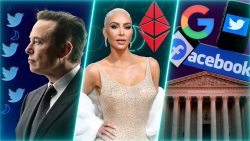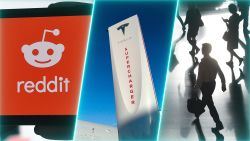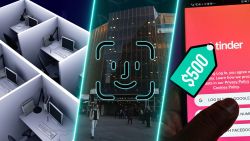This story is part of CNN Business’ Nightcap newsletter. To get it in your inbox, sign up for free, here.
It’s easy to feel down about the state of the world, what with that looming global recession, the pandemic, those people who insist they unironically love candy corn … and so on.
All of that is enough to make anyone curious about this metaverse thing Mark Zuckerberg keeps touting as the future of the internet. This is the digital destination where Zuck expects us to spend more and more of our time — at work, but not really, or hanging out with avatar friends at not-real coffee shops.
He’s so convinced of this future that last year he renamed Facebook, the company he founded, to Meta, and is plowing billions of dollars into building the hardware that will transport us there.
On Tuesday, Meta unveiled its latest effort in that mission, the Meta Quest Pro headset.
As my colleague Rachel Metz reports, this thing is slick, powerful, and much improved from earlier iterations. And still super impractical.
In short: It’s a cool gadget in search of an audience.
Per Rachel:
It can display text and fine details in VR, making it possible to read even small type with ease. It can track your eyes and facial features, giving you a sense of connection with other people in virtual spaces: If you arch your eyebrows or they puff up their cheeks in real life, so too will the VR avatars. And it can be used as a mixed-reality headset, showing you a view of the world around you in color while letting you interact with digital objects — whether you’re painting on an ersatz easel or putting on a faux mini-golf course.
But it costs $1,500 — nearly four times that of the company’s cheapest Quest 2 headset. That might be OK for deep-pocketed professionals like architects and designers, or perhaps for the well-to-do VR faithful who are emotionally invested in the metaverse idea.
But for normies, that’s a lot of dough. Too much, you might say, in an economy that’s hobbled by high prices and potentially tumbling into a recession. For that price, you could buy two Xbox Series X gaming consoles and still have money left over for brunch. You could buy a top-of-the-line iPhone and a flight to Denver. Heck, you could skip the gadgets, book a flight to Italy and sip some very real, delicious wine food for a few days all for the price of a single Quest Pro, which promises… I dunno, some nice graphics?
Time will tell: Customers can pre-order the headset starting today and it’ll ship later this month.
BIG PICTURE
As Rachel notes, the Quest Pro may not be the Tickle Me Elmo of the 2022 holiday season (Gen Zers, you can ask your parents about that one). But its improved design is a milestone for Zuck and his Meta dream, which cost the company $2.8 billion in losses the second quarter alone.
The lenses are thinner, the headset itself less front-heavy than earlier iterations, and it reportedly does a better job blending the real and virtual spaces around the user. Which all sounds like a step in the right direction, if you’re someone who believes the right direction is ultimately one in which our lives eventually revolve even more than they do now around being digitally connected to one another.
NUMBER OF THE DAY: 12%
Lyft shares tumbled 12% while Uber’s sank 10% after the Biden administration announced a new proposed labor rule that could reclassify gig workers — the bulk of those companies’ drivers — as employees. Such a change, which the rideshare companies have fought in the past, could entitle millions of gig workers across industries to benefits such as minimum wage and overtime pay.
AMERICANA
A constant theme of the 2020s so far is that nothing is quite as expected. Not our politics, not our grasp of Covid-19, and, perhaps more than anything else, you can pretty much throw out what you thought you knew about the US labor market.
See here: The pandemic’s upheaval of global supply chains pushed manufacturers at home to ramp up production as it got harder and harder (and took longer and longer) to move goods around the globe. Suddenly the domestic producer that used to cost more made a lot more sense than the cheaper one overseas.
The upshot is that US factories are suddenly humming, my colleagues Chris Isidore and Christine Romans report.
Last week, the September jobs report showed US manufacturers added another 22,000 workers. And right now, the nearly 13 million people employed in American factories make up the industry’s largest workforce since the Great Recession that began in 2007.
It’s not all good news (because, honestly, what is these days?).
The problem now is finding enough skilled workers to keep up. And it’s not just a problem of pay.
Wages are up an estimated 5% this year in manufacturing — that’s not keeping up with inflation, but it is in line with the national average. Factory jobs also tend to pay more than other private sector jobs overall — about $65,000 annually, according to the Labor Department.
So, what gives?
For one, you can’t just let factories decline for years and then expect them to snap back to peak production with the flip of a switch.
“I think we’re in uncharted territory,” said Jay Timmons, CEO of the National Association of Manufacturers. “For every 100 jobs openings in the sector we only have 60 people who are looking. I think it’ll take quite a while to fill that pipeline.”
Then there’s the perception problem: Factory life conjures images of an industry in decline, as it was for so long between 2007 and 2020. That’s a tough reputation to reform.
“We often take a look at the images of manufacturing and we see the sparks flying … and perhaps it’s a little bit dingy, dark,” says Eric Esoda, CEO of a not-for-profit manufacturing consultancy. “But by and large our manufacturing jobs today are high tech.”
Bottom line: The labor story in America remains one where the narrative of recent history doesn’t quite hold. In most downturns, we’ve seen manufacturing decline, giving it a bad rap as a job that’s going extinct. Factories aren’t alone. And managers are going to have to figure out the right combination of pay (humble suggestion: raise it), benefits and growth potential if they want to attract any of the millions of people (especially women) who are opting out of the labor force completely.
Enjoying Nightcap? Sign up and you’ll get all of this, plus some other funny stuff we liked on the internet, in your inbox every night. (OK, most nights — we believe in a four-day work week around here.)




































